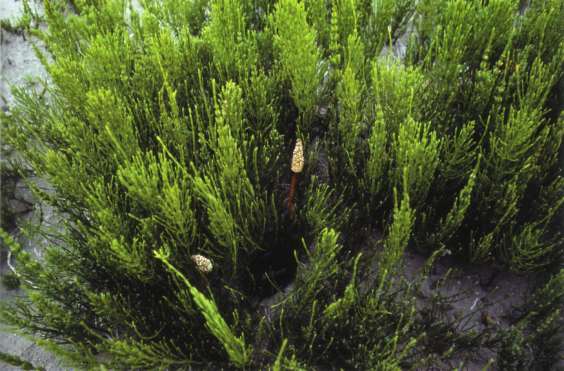|
 An
Illustrated Guide to An
Illustrated Guide to
Common Weeds
of New Zealand
Equisetum
arvense
field
horsetail
Family
EQISETACEAE
Reproduced from
Common
Weeds of New Zealand
by Ian Popay, Paul Champion & Trevor James
ISBN 0 473 09760 5
by kind permission of the
New Zealand Plant
Protection Society
Publication or other use of images or descriptive
text on these pages is unauthorised unless written permission is
obtained from the authors and publisher.
Appropriate acknowledgement
of the publication Common Weeds of New Zealand must always
be given.
Available from Nationwide Book Distributors
Erect, rhizomatous,
colony-forming perennial. Shoots with whorls of needle-like branches
similar to spurrey. Aerial parts die back each winter and appear
again in spring. Cone-like structures at the tip of fertile shoots.
Allied to ferns.
- Flowers No
flowers, but cone-like structures, 1-4 cm long, at the tips of
fertile stems contain spores.
- Fruit No
fruit.
- Leaves Long,
thin, needle-like branches in whorls resemble leaves.
- Stems Erect,
green, grooved, with branches in whorls, sterile, up to 80 mm
long by 5 mm diameter. Smaller but thicker, unbranched, brown
fertile stems appear in spring and die after shedding spores in
summer.
- Roots Extensive
underground rhizomes, bearing round tubers, creeping and branching
freely penetrate to considerable depths, especially in shifting
sand banks in rivers.
Habitat
Damp ground, river-banks,
lake margins and sandy or gravelly soils.
Distribution
Uncommon but recorded
from Kawhia, Havelock North, New Plymouth, Wanganui, and lower
Rangitikei in NI. Marlborough, Nelson (200 ha infestation in a
valley near Karamea), Christchurch and Dunedin in SI. Originally
from temperate regions of northern hemisphere.
Comments
Used a pot scourer
in olden days in Europe, and for some homeopathic preparations.
Very difficult to control either with herbicides or by cultivation.
Common weed in parts of Europe. Species is toxic to animals. Of
limited distribution in NZ, and could become more widespread.
Listed on the National Pest Plant Accord
(see Introduction for details).
Derivation
of name
Equisetum (Lat.)
= horse bristle, the sterile stems resembling horses' tails; arvense
(Lat.) = of cultivated fields.
Web-notes:
Weed Links
On this site
Reproduced from Common Weeds
of New Zealand:
External Links
 Weedbusters
New Zealand Weedbusters
New Zealand
- Weedbusters is a weeds awareness and education programme that aims to
protect New Zealand's environment from the increasing weed problem.
- AgPest
- A free tool to assist farmers and agricultural professionals in decision-making regarding weed and pest identification, biology, impact and management.
 New Zealand Weeds Key New Zealand Weeds Key
- An interactive identification key to the weeds of New Zealand. Developed at Landcare Research.
New
Zealand Plant Conservation Network naturalised plants
- Search for information on more than 2500 naturalised and weedy plants.
 New
Zealand Plant Protection Society New
Zealand Plant Protection Society
- Their main objective: "To pool and exchange information on the biology
of weeds, invertebrate and vertebrate pests, pathogens and beneficial organisms
and methods for modifying their effects."
-
 Massey
University Weeds Database Massey
University Weeds Database- A site providing information about New Zealand weeds and weed control.
It has a series of pages showing pictures of New Zealand weeds, notes on
identification and control. It also provides information on a university
paper entitled Controlling Weeds.
-
-
More
Plant Profiles
|







